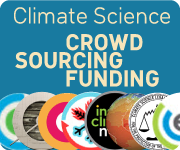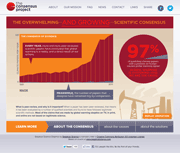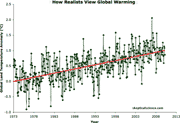Skeptical Science New Research for Week #15 2025
Posted on 10 April 2025 by Doug Bostrom, Marc Kodack
Open access notables
Global and regional drivers for exceptional climate extremes in 2023-2024: beyond the new normal, Minobe et al., npj Climate and Atmospheric Science:
Climate records have been broken with alarming regularity in recent years, but the events of 2023–2024 were exceptional even when accounting for recent climatic trends. Here we quantify these events across multiple variables and show how excess energy accumulation in the Earth system drove the exceptional conditions. Key factors were the positive decadal trend in Earth’s Energy Imbalance (EEI), persistent La Niña conditions beginning in 2020, and the switch to El Niño in 2023. Between 2022 and 2023, the heating from EEI was over 75% larger than during the onset of similar recent El Niño events. We show further how regional processes shaped distinct patterns of record-breaking sea surface temperatures in individual ocean basins. If the recent trend in EEI is maintained, we argue that natural fluctuations such as ENSO cycles will increasingly lead to amplified, record-breaking impacts, with 2023–2024 serving as a glimpse of future climate extremes.
Subglacial water amplifies Antarctic contributions to sea-level rise, Zhao et al., Nature Communications:
Antarctica’s contribution to global sea-level rise is deeply uncertain, with subglacial water suspected to play a critical role, yet its impact remains unclear. We demonstrate that water at the base of ice sheets influences sliding behaviour and that its exclusion from models can underestimate sea-level rise projections and delay the predicted onset of tipping points. Here we use an Antarctic Ice Sheet model (Elmer/Ice) to explore how different assumptions about water pressure at the ice base affect sea-level rise projections from 2015 to 2300. Our results indicate that incorporating subglacial water can amplify ice discharge across the Antarctic Ice Sheet by up to threefold above the standard approach, potentially contributing an additional 2.2 metres to sea-level rise by 2300. Notably, a smoothly decreasing basal drag near the grounding line more than doubles grounding line flux by 2300 relative to scenarios where effective pressure is simplified into a spatially constant coefficient. Basin-specific responses vary significantly, with some scenarios advancing tipping points by up to 40 years. These findings underscore the critical need to integrate evolving subglacial hydrology into ice sheet models.
The net ecosystem carbon balance (NECB) at catchment scales in the Arctic, López-Blanco et al., Frontiers in Environmental Science:
The Net Ecosystem Carbon Balance (NECB) is a crucial metric for understanding integrated carbon dynamics in Arctic and boreal regions, which are vital to the global carbon cycle. These areas are associated with significant uncertainties and rapid climate change, potentially leading to unpredictable alterations in carbon dynamics. This mini-review examines key components of NECB, including carbon sequestration, methane emissions, lateral carbon transport, herbivore interactions, and disturbances, while integrating insights from recent permafrost region greenhouse gas budget syntheses. We emphasize the need for a holistic approach to quantify the NECB, incorporating all components and their uncertainties. The review highlights recent methodological advances in flux measurements, including improvements in eddy covariance and automatic chamber techniques, as well as progress in modeling approaches and data assimilation. Key research priorities are identified, such as improving the representation of inland waters in process-based models, expanding monitoring networks, and enhancing integration of long-term field observations with modeling approaches. These efforts are essential for accurately quantifying current and future greenhouse gas budgets in rapidly changing northern landscapes, ultimately informing more effective climate change mitigation strategies and ecosystem management practices. The review aligns with the goals of the Arctic Monitoring and Assessment Program (AMAP) and Conservation of Arctic Flora and Fauna (CAFF), providing important insights for policymakers, researchers, and stakeholders working to understand and protect these sensitive ecosystems.
Effects of ocean alkalinity enhancement on plankton in the Equatorial Pacific, Guo et al., Communications Earth & Environment:
Ocean alkalinity enhancement is a potential strategy for gigatonne-scale atmospheric carbon dioxide removal. It uses alkaline substances to convert seawater carbon dioxide into (bi)carbonate, enabling uptake of additional carbon dioxide from the atmosphere. A critical knowledge gap is how ocean alkalinity enhancement could influence marine plankton communities. Here we conducted 19 ship-based experiments in the Equatorial Pacific, examining three prevalent alkaline substances (sodium hydroxide, olivine, and steel slag) and their effects on natural phytoplankton populations under realistic and moderate alkalinity enhancements (16–29 μmol kg−1). Results demonstrate that sodium hydroxide had a negligible effect on phytoplankton while providing predictable alkalinity. Conversely, olivine disrupted plankton, especially cyanobacteria, heterotrophic bacteria, and picoeukaryotes while only providing 0.06 mmol alkalinity g−1 olivine. Steel slag moderately changed phytoplankton communities and fertilized growth while delivering 8 mmol alkalinity g−1 slag. Our study helps to determine which alkaline substance could be suitable for application in the Equatorial Pacific.
The gaze from afar: climate action despite the loss of hope, Cassegård et al., Environmental Politics:
Regarding climate change, catastrophic developments are already ongoing. This does not eliminate the hope that meaningful climate action is possible but can lead to other emotions and emotive-cognitive orientations becoming more central in motivating collective action. We argue for the crucial role of a ‘gaze from afar’, which can validate action even without hope of averting catastrophe. Such a gaze breaks with the conventional model of empathic role-taking by judging one’s present actions from the point of view of a distant other. This paper draws on a project on post-apocalyptic environmental activism to illuminate two different variants of the gaze from afar: that of people who do not share our present and that of non-human others. In each case the gaze helps propel a heightened degree of moral reflexivity and existential responsibility that can motivate collective action in the midst of ongoing catastrophe.
From this week's government/NGO section:
Extraordinary March heatwave in Central Asia up to 10°C hotter in a warming climate, Clarke et al., World Weather Attribution
In March 2025, Central Asia experienced an unusually intense heatwave, with temperatures reaching record highs across the region, reaching maxima of 30.8°C Jalalabad in Kyrgyzstan, 29.4°C Namangan, 29.1°C Fergana, in Uzbekistan and minimum temperatures of 18.3°C in Shahdara, making it the hottest March night in Kazakhstan’s history. When combining the observation-based analysis with climate models, to quantify the role of climate change in this 5-day heat event, the authors found that climate models underestimate the increase in heat found in observations. In particular, all observations show a particular increase in March maximum and minimum temperatures in recent years that is much stronger than in all other months and not represented in the climate models. The authors can thus only give a conservative estimate of the influence of human-induced climate change. Based on the combined analysis they conclude that climate change made the extreme heat about 4 °C hotter and about 3 times more likely.
Hunting Methane Using Satellites: A Guide for Policymakers, Shukla et al., The Center for Law, Energy & the Environment, University of California, Berkeley and The Emmett Institute on Climate Change and the Environment, University of California, Los Angeles
Methane is a powerful greenhouse gas, over 80 times more potent than carbon dioxide in the short term. Reducing methane emissions is one of the fastest ways to slow global warming, but tracking sources and enforcing reductions has long been a challenge—until now. Thanks to a new generation of space-based instruments, satellites can detect methane leaks in real time, offering unprecedented transparency and accountability. The authors explain how policymakers can harness satellite data to improve climate policies, enforce emissions regulations, and accelerate methane reduction efforts. They provide a roadmap for integrating these technologies into decision-making, offering practical recommendations for governments, regulators, and industry leaders.
170 articles in 61 journals by 1088 contributing authors
Physical science of climate change, effects
Changes in the Regional Water Cycle and Their Impact on Societies, Lambert et al., WIREs Climate Change Open Access 10.1002/wcc.70005
Changes of atmospheric warming associated with rapid sea ice loss events on the synoptic time scale in winter, Hu et al., Atmospheric Research 10.1016/j.atmosres.2025.108129
Emergence of an oceanic CO2 uptake hole under global warming, Lee et al., Nature Communications Open Access 10.1038/s41467-025-57724-7
Estimates of the Global Clear-Sky Longwave Radiative Feedback Strength From Reanalysis Data, Gloeckner et al., Geophysical Research Letters Open Access 10.1029/2024gl113495
Pristine oceans are a significant source of uncertainty in quantifying global cloud condensation nuclei, Choudhury et al., Atmospheric Chemistry and Physics Open Access 10.5194/acp-25-3841-2025
The knowns and unknowns in our understanding of how plastics impact climate change: a systematic review, Zhu et al., Frontiers in Environmental Science Open Access 10.3389/fenvs.2025.1563488
Observations of climate change, effects
Fluvial erosion linked to warming in the Canadian Arctic, Fields et al., Communications Earth & Environment Open Access 10.1038/s43247-025-02234-z
Global and regional drivers for exceptional climate extremes in 2023-2024: beyond the new normal, Minobe et al., npj Climate and Atmospheric Science Open Access 10.1038/s41612-025-00996-z
Instrumentation & observational methods of climate change, effects
A high-resolution (0.05°) global seamless continuity record (2002–2023) of near-surface soil freeze-thaw states via passive microwave and optical satellite data, Feng et al., Open Access 10.5194/essd-2025-62
A Reanalysis-Based Global Tropical Cyclone Tracks Dataset for the Twentieth Century (RGTracks-20C), Ye et al., Open Access 10.5194/essd-2025-126
CLIMADAT-GRid: A high-resolution daily gridded precipitation and temperature dataset for Greece, Varotsos et al., Open Access 10.5194/essd-2025-29
The International Altimetry Service 2024 (IAS2024) coastal sea level dataset and first evaluations, Peng et al., Earth System Science Data Open Access 10.5194/essd-17-1441-2025
Modeling, simulation & projection of climate change, effects
Future increases in Eurasian mid-latitude winter temperature variability shaped by a weakened Atlantic Meridional Overturning Circulation, Lee et al., Communications Earth & Environment Open Access 10.1038/s43247-025-02249-6
Future Wave Climate in the Mediterranean Sea and Associated Uncertainty From an Ensemble of 31 GCM-RCM Wave Simulations, Toomey et al., Earth's Future Open Access 10.1029/2024ef004992
Higher precipitation in East Asia and western United States expected with future Southern Ocean warming, Kim et al., Nature Geoscience Open Access 10.1038/s41561-025-01669-5
Likelihoods of compound dry-hot-windy events are projected to increase under global warming, Ma et al., Atmospheric Research 10.1016/j.atmosres.2025.108119
Projected Changes in Indian Ocean Dipole Pattern under Greenhouse Warming, Zheng et al., Journal of Climate 10.1175/jcli-d-24-0475.1
Suppressed AMOC multidecadal variability by freshwater flux change in the Community Earth System Model version 1.0, Gao et al., Global and Planetary Change 10.1016/j.gloplacha.2025.104794
Weak enhancement of carbon fixation in the Northern Hemisphere terrestrial ecosystems by aerosol emissions during 1980–2014 with the Community Earth System Model, Zhang et al., Global and Planetary Change 10.1016/j.gloplacha.2025.104827
Advancement of climate & climate effects modeling, simulation & projection
An improved and extended parameterization of the CO2 15 µm cooling in the middle and upper atmosphere (CO2&cool&fort-1.0), López-Puertas et al., Geoscientific Model Development Open Access 10.5194/gmd-17-4401-2024
Assessment of convection-permitting hydroclimate modeling in urban areas across the contiguous United States, Thompson et al., Urban Climate 10.1016/j.uclim.2025.102375
Biases in Climate Model Global Warming Trends Related to Deficiencies in Southern Ocean Sea Ice Evolution Over Recent Decades, Mutton & Andrews Andrews, Geophysical Research Letters Open Access 10.1029/2025gl115657
Global-Scale Multidecadal Variability in Climate Models and Observations. Part I: Forced Response, Kravtsov et al., Journal of Climate 10.1175/jcli-d-24-0456.1
Historical trends and controlling factors of isoprene emissions in CMIP6 Earth system models, Do et al., Open Access 10.5194/egusphere-2024-2313
Model Sensitivity to Insolation Forcing and Uncertainties in Holocene Temperature Simulations, Bao et al., Paleoceanography and Paleoclimatology 10.1029/2024pa004958
Cryosphere & climate change
Equilibrium line altitudes, accumulation areas and the vulnerability of glaciers in Alaska, Zeller et al., Journal of Glaciology Open Access 10.1017/jog.2024.65
Sea level & climate change
Subglacial water amplifies Antarctic contributions to sea-level rise, Zhao et al., Nature Communications Open Access 10.1038/s41467-025-58375-4
Paleoclimate & paleogeochemistry
Climate Control on Erosion: Evolution of Sediment Flux From Mountainous Catchments During a Global Warming Event, PETM, Southern Pyrenees, Spain, Prieur et al., Geophysical Research Letters Open Access 10.1029/2024gl112404
Contraction of the Western Pacific Tropical Rain Belt and Weakening of the Walker Circulation: Future Lessons From the Past Two Interglacials, Bova et al., Paleoceanography and Paleoclimatology 10.1029/2024pa004997
Extended Duration of Abrupt Climate Events From the Early to Late Holocene, Liu et al., Geophysical Research Letters Open Access 10.1029/2025gl115543
Biology & climate change, related geochemistry
A Dark Future of Endangered Mountain Species, Parnassius bremeri, Under Climate Change, Koo & Park, Ecology and Evolution Open Access 10.1002/ece3.71178
A Global Synthesis of How Plants Respond to Climate Warming From Traits to Fitness, Jia et al., Ecology Letters 10.1111/ele.70114
Causes and consequences of insect decline in tropical forests, Boyle et al., Nature Reviews Biodiversity 10.1038/s44358-025-00038-9
Chasing the Niche: Escaping Climate Change Threats in Place, Time, and Space, Muthukrishnan et al., Global Change Biology 10.1111/gcb.70167
Climate Change and Human Pressure: Assessing the Vulnerability of Snow Leopard (Panthera uncia) Habitat Integrated With Prey Distribution on the Qinghai-Tibet Plateau, Zhang et al., Ecology and Evolution Open Access 10.1002/ece3.71232
Climate-Driven Range Shifts and Conservation Challenges for Brown Bears in Türkiye, S?kdokur et al., Ecology and Evolution Open Access 10.1002/ece3.71019
Could Tropical Cyclone Expansion Boost Migration of Temperate Trees to Boreal Forests?, Altman & Korznikov, WIREs Climate Change Open Access 10.1002/wcc.70006
Current approaches and future opportunities for climate-smart protected areas, Buenafe et al., Nature Reviews Biodiversity 10.1038/s44358-025-00041-0
Decoupling Responses of Phyllosphere and Rhizosphere Bacterial Communities to Spatiotemporal Environmental Changes, Chen et al., Global Change Biology 10.1111/gcb.70175
Ectomycorrhizal response to bark beetle attack: a comparison of dead and surviving trees, Modlinger et al., Frontiers in Forests and Global Change Open Access 10.3389/ffgc.2025.1492622
Global floating kelp forests have limited protection despite intensifying marine heatwave threats, Arafeh-Dalmau et al., Nature Communications Open Access 10.1038/s41467-025-58054-4
Insect Herbivory Releases More Nutrients in Warmer and Drier Forests, Hwang et al., Global Biogeochemical Cycles Open Access 10.1029/2024gb008367
Interplay between snow phenology and vegetation phenology in Alaska under climate change, MU et al., Advances in Climate Change Research Open Access 10.1016/j.accre.2025.04.001
Laboratory experiments revealed different bleaching susceptibilities to heat stress in eight species of subtropical urban corals, Yeung et al., Marine Environmental Research Open Access 10.1016/j.marenvres.2025.107132
Life on the dry side: a roadmap to understanding desiccation tolerance and accelerating translational applications, Marks et al., Nature Communications Open Access 10.1038/s41467-025-58656-y
Mangroves and their services are at risk from tropical cyclones and sea level rise under climate change, Hülsen et al., Communications Earth & Environment Open Access 10.1038/s43247-025-02242-z
Multiple Models of European Marine Fish Stocks: Regional Winners and Losers in a Future Climate, Sailley et al., Global Change Biology Open Access 10.1111/gcb.70149
Novel Regimes of Extreme Climatic Events Trigger Negative Population Rates in a Common Insect, Vives?Ingla et al., Global Change Biology 10.1111/gcb.70148
Population Genetics Provides Insights Into the Impact of Future Climate Change on the Genetic Structure and Distribution of Asian Warty Newts (Genus Paramesotriton), Van Tran et al., Ecology and Evolution Open Access 10.1002/ece3.71054
review on atmospheric aerosols and dusts in different tropical forest ecosystems and policy recommendations toward climate resilience, Bridhikitti et al., Atmospheric Environment Open Access 10.1016/j.atmosenv.2025.121215
Seed Production and 22 Years of Climatic Changes in an Everwet Neotropical Forest, Vleminckx et al., Ecology Letters 10.1111/ele.70019
Simulated intertidal heat stress on the brown seaweed Ascophyllum nodosum demonstrates differential population sensitivity to future climate, Pereira et al., Journal of Ecology Open Access 10.1111/1365-2745.70037
The effects of climate on bat morphology across space and time, Paltrinieri et al., Ecography Open Access 10.1002/ecog.07663
The Thermal Stress History of South Atlantic Reefs Reveals Increasing Intensity, Duration, Frequency, and Likely Undocumented Bleaching Episodes, Destri et al., Global Change Biology 10.1111/gcb.70162
Trees outside forests in Ghana: current state, spatial distribution, and future projection, Kusi, Frontiers in Forests and Global Change Open Access 10.3389/ffgc.2025.1540910
Urbanization Pressures on Climate Adaptation Capacity of Forest Habitats, Huang et al., Global Change Biology 10.1111/gcb.70166
Voltinism Shifts in Response to Climate Warming Generally Benefit Populations of Multivoltine Butterflies, Wepprich et al., Ecology Letters Open Access 10.1111/ele.70018
Warming promotes divergent shift in sequential phenophases of alpine meadow plants, Chen et al., Agricultural and Forest Meteorology 10.1016/j.agrformet.2025.110521
GHG sources & sinks, flux, related geochemistry
A data-efficient deep transfer learning framework for methane super-emitter detection in oil and gas fields using the Sentinel-2 satellite, Zhao et al., Open Access 10.5194/egusphere-2024-2565
Aerial Estimates of Methane and Carbon Dioxide Emission Rates Using a Mass Balance Approach in New York State, Catena et al., Open Access 10.5194/essd-2025-135
Biomass and carbon stock of conifer and broad-leaf forest stands in Talra Wildlife Sanctuary across Northwest Himalayas, India, Kumar et al., Frontiers in Forests and Global Change Open Access 10.3389/ffgc.2025.1566614
CHN-CH4: A Gridded (0.1°×0.1°) Anthropogenic Methane Emission Inventory of China from 1990 to 2020, Guo et al., Open Access 10.5194/essd-2025-178
Divergent vegetation greening's direct impacts on land-atmosphere water and carbon exchanges in the northeastern Tibetan Plateau, Luo et al., Global and Planetary Change 10.1016/j.gloplacha.2025.104825
Drivers of persistent changes in the global methane cycle under aggressive mitigation action, Folberth et al., npj Climate and Atmospheric Science Open Access 10.1038/s41612-024-00867-z
Ecosystem Carbon Fluxes Exhibit Thermal Response Thresholds at Which Carbon–Climate Feedback Changes, Xu et al., Global Ecology and Biogeography 10.1111/geb.70030
Global warming, carbon cycles, forests and photosynthesis; a hypothesis for global cooling, John, Frontiers in Earth Science Open Access 10.3389/feart.2025.1554362
Lightning Impacts on Global Forest and Carbon Dynamics: Current Understanding and Knowledge Gaps, Veraverbeke et al., Global Change Biology Open Access 10.1111/gcb.70179
Pacific-Arctic Ocean Acidification: Decadal Trends and Drivers, Caero et al., Global Biogeochemical Cycles Open Access 10.1029/2024gb008249
Paleoclimate contributes to soil carbon storage in subtropical shrublands, Ge et al., Agricultural and Forest Meteorology 10.1016/j.agrformet.2025.110528
Performance of Airborne Imaging Spectrometers for Carbon Dioxide Detection and Emission Quantification, Kim et al., Journal of Geophysical Research: Atmospheres Open Access 10.1029/2024jd042755
Rapid Infill of Abandoned Tidal Channels Creates Hotspots for Blue-Carbon Accumulation in Coastal Wetlands, Puppin et al., Geophysical Research Letters Open Access 10.1029/2024gl113705
Rodent-induced grassland degradation increases annual non-CO2 greenhouse gas fluxes and NO losses despite CH4 uptake enhancement, Yao et al., Agricultural and Forest Meteorology 10.1016/j.agrformet.2025.110534
Spatial and temporal variations of gross primary production simulated by land surface model BCC&AVIM2.0, Li et al., Advances in Climate Change Research Open Access 10.1016/j.accre.2023.02.001
Stabilisation and destabilisation of coastal blue carbon: The key factors, Macreadie et al., Earth Open Access 10.1016/j.earscirev.2025.105133
The increase of aquatic vegetation raised methane emissions from northern lakes, , Nature Geoscience 10.1038/s41561-025-01668-6
The net ecosystem carbon balance (NECB) at catchment scales in the Arctic, López-Blanco et al., Frontiers in Environmental Science Open Access 10.3389/fenvs.2025.1544586
CO2 capture, sequestration science & engineering
Climate mitigation potential for targeted forestation after considering climate change, fires, and albedo, Wang et al., 10.5194/egusphere-egu25-16490
Estimates vary but credible evidence points to gigaton-scale climate change mitigation potential of biochar, Weng & Cowie, Communications Earth & Environment Open Access 10.1038/s43247-025-02228-x
From Site Selection to Characterization: Assessment of Potential Reservoirs in the Lurestan Basin of Iran for Carbon Sequestration, Dinani et al., Greenhouse Gases: Science and Technology Open Access 10.1002/ghg.2339
Integrated Carbon Capture and Storage Strategies in Hard-to-Abate Industries for Achieving Vietnam's Net Zero by 2050, Nguyen, Greenhouse Gases: Science and Technology 10.1002/ghg.2341
Riverine photosynthesis influences the carbon sequestration potential of enhanced rock weathering, Neumann et al., Frontiers in Climate Open Access 10.3389/fclim.2025.1582786
Synergies of storing hydrogen at the crest of CO2${rm CO}&{2}$ or other gas storage, Rhouma et al., Greenhouse Gases: Science and Technology Open Access pdf 10.1002/ghg.2278
Who cares about carbon dioxide removal? Assessing actors, policy positions, and participation modes within European and United Nations public consultation processes, Losi et al., Climate Policy Open Access 10.1080/14693062.2025.2485204
Decarbonization
Development Status and Future Prospects of Hydrogen Energy Technology: Production, Storage, and Cost Analysis, Pan et al., Advanced Energy and Sustainability Research Open Access 10.1002/aesr.202400451
Global warming potential and environmental impacts of electric vehicles and batteries in Association of Southeast Asian Nations (ASEAN), Champeecharoensuk et al., Energy for Sustainable Development 10.1016/j.esd.2025.101723
Leveraging meat cold storage effect on a solar-powered freezing system in Mongolia, Kashida et al., Energy for Sustainable Development Open Access 10.1016/j.esd.2025.101710
Mapping the potential: A GIS-based approach to assessing floating solar resources for rural electrification in Cambodia, Wang et al., Energy for Sustainable Development 10.1016/j.esd.2025.101724
Perspective on challenges and opportunities in integrated electricity-hydrogen market, Mochi, Energy for Sustainable Development 10.1016/j.esd.2025.101728
Recent Progress on Redox Materials for High-Temperature Thermochemical Heat Storage, Carrillo & Serra, Advanced Energy and Sustainability Research Open Access 10.1002/aesr.202400317
Rooftop solar can reduce energy insecurity, , Nature Energy Open Access 10.1038/s41560-025-01750-8
To what extent can flexibility options reduce the need for hydrogen backup power plants?, Brunner et al., Energy Policy 10.1016/j.enpol.2025.114551
Geoengineering climate
Effects of ocean alkalinity enhancement on plankton in the Equatorial Pacific, Guo et al., Communications Earth & Environment Open Access 10.1038/s43247-025-02248-7
Novel marine-climate interventions hampered by low consensus and governance preparedness, Ogier et al., Nature Climate Change Open Access 10.1038/s41558-025-02291-4
Simulated response of the climate of eastern Africa to stratospheric aerosol intervention, Misiani et al., Frontiers in Climate Open Access 10.3389/fclim.2025.1522235
Aerosols
Analyses of Virtual Ship-Tracks Systematically Underestimate Aerosol-Cloud Interactions Signals, Yuan et al., Geophysical Research Letters Open Access 10.1029/2024gl114356
High sensitivity of cloud formation to aerosol changes, Virtanen et al., Nature Geoscience Open Access 10.1038/s41561-025-01662-y
Hygroscopic aerosols amplify longwave downward radiation in the Arctic, Ji et al., Atmospheric Chemistry and Physics Open Access 10.5194/acp-25-3889-2025
Understanding the long-term trend of organic aerosol and the influences from anthropogenic emission and regional climate change in China, Zhang et al., Atmospheric Chemistry and Physics Open Access 10.5194/acp-25-3857-2025
Climate change communications & cognition
Associations between religiosity and climate change beliefs and behaviours in the Avon Longitudinal Study of Parents and Children (ALSPAC), Major-Smith et al., Open Access pdf 10.31219/osf.io/rqz3f
Most Africans place primary responsibility for climate action on their own government, Andrews et al., Communications Earth & Environment Open Access 10.1038/s43247-025-02244-x
The Gateway Belief Model: A pre-registered large-scale replication in China, Zeng et al., Journal of Environmental Psychology 10.1016/j.jenvp.2025.102542
The gaze from afar: climate action despite the loss of hope, Cassegård et al., Environmental Politics Open Access 10.1080/09644016.2025.2487337
The paradox of environmental consciousness: dissecting the gap between climate change awareness, environmental concern and policy support, Peñasco & Grossman, Climate Policy Open Access 10.1080/14693062.2025.2479814
Agronomy, animal husbundry, food production & climate change
Changes in Plant Hardiness Zones under Climate Change Scenarios in the South-Central United States, Tefera et al., Journal of Applied Meteorology and Climatology 10.1175/jamc-d-24-0080.1
Climate-Induced Range Shift and Risk Assessment of Emerging Weeds in Queensland, Australia, Osunkoya et al., Ecology and Evolution Open Access 10.1002/ece3.71043
Cork-ring width responds to climate depending on local site dryness, Camarero et al., Dendrochronologia 10.1016/j.dendro.2025.126339
Expert-driven explainable artificial intelligence models can detect multiple climate hazards relevant for agriculture, Hrast Essenfelder et al., Communications Earth & Environment Open Access 10.1038/s43247-024-01987-3
Global agricultural adaptation case database and trend analysis based on large language models, Jing-Wen et al., Advances in Climate Change Research Open Access 10.1016/j.accre.2025.03.013
Grain for Green Program to Grassland Might Lead to Carbon Sink Leakage in the Loess Plateau, Ma et al., Earth's Future Open Access 10.1029/2024ef005261
Historical and Projected Changes in Chill Accumulation and Spring Freeze Risk in the Midwest United States, Ford et al., Agricultural and Forest Meteorology 10.1016/j.agrformet.2025.110532
Inorganic Carbon Should Be Considered for Carbon Sequestration in Agricultural Soils, Liao et al., Global Change Biology 10.1111/gcb.70160
Modeling biochar effects on soil organic carbon on croplands in a microbial decomposition model (MIMICS-BC&v1.0), Han et al., Geoscientific Model Development Open Access 10.5194/gmd-17-4871-2024
Nexus of climate change adaptation and household wealth in climate risk hotspots – Insights from rural farm households of Pakistan, Wang et al., Climate Risk Management Open Access 10.1016/j.crm.2025.100704
Olive production in the 21st century will be threatened by water stress and declining solar activity, Kaniewski et al., Communications Earth & Environment Open Access 10.1038/s43247-025-02256-7
Organic carbon sequestration in global croplands: evidenced through a bibliometric approach, Abrar et al., Frontiers in Environmental Science Open Access 10.3389/fenvs.2025.1495991
Small Ponds as Carbon Emission and Burial Hotspots in Lowland Agricultural Landscape, Ji et al., Earth's Future Open Access 10.1029/2024ef005441
The economic and carbon emission benefits of container farms under different photovoltaic storage configurations, Guo et al., Energy for Sustainable Development Open Access 10.1016/j.esd.2025.101674
The Impact of Turfgrass on Urban Carbon Dioxide Fluxes in Indianapolis, Indiana, USA, Horne et al., Journal of Geophysical Research: Biogeosciences 10.1029/2024jg008477
Widespread Advances in Corn and Soybean Phenology in Response to Future Climate Change Across the United States, Yang et al., Journal of Geophysical Research: Biogeosciences 10.1029/2024jg008266
Hydrology, hydrometeorology & climate change
Response of Australian Summer Monsoon Precipitation to a Strengthening Antarctic Circumpolar Current, Han et al., Geophysical Research Letters Open Access 10.1029/2024gl113080
Climate change economics
Climate finance and global justice, Dafermos, Climate Policy Open Access 10.1080/14693062.2025.2482104
From informal coordination to formalised policy integration: options for strengthening climate change adaptation in EU finance and trade policy, Pitzén et al., Frontiers in Climate Open Access 10.3389/fclim.2025.1543732
Greener horizons: Economic freedom as a catalyst for the global energy transition, Hailemariam & Ivanovski, Energy Research & Social Science Open Access 10.1016/j.erss.2025.104058
Job seekers have more suitable job opportunities in decarbonization in the Global North than in the Global South, Zhao et al., Communications Earth & Environment Open Access 10.1038/s43247-025-02230-3
PFAS insights: A review of historical data, environmental applications, health effects, and pollution challenges in Pakistan, Chaudhary et al., Environmental Science & Policy 10.1016/j.envsci.2025.104056
Trade risks to energy security in net-zero emissions energy scenarios, Cheng et al., Nature Climate Change 10.1038/s41558-025-02305-1
Climate change mitigation public policy research
A just transition for all: workers and communities for a carbon-free future, Davidson, Environmental Politics 10.1080/09644016.2025.2489204
A Pareto superior incentive scheme for residential electricity conservation, Woo et al., Energy Policy 10.1016/j.enpol.2025.114588
A study on the porter effect of China’s carbon emissions trading policy, Kebei et al., Frontiers in Environmental Science Open Access 10.3389/fenvs.2025.1555798
An enhanced moth flame optimization extreme learning machines hybrid model for predicting CO2 emissions, Algwil & Khalifa, Scientific Reports Open Access 10.1038/s41598-025-95678-4
Analyzing decarbonization policies targeting interdependent electric power and water desalination infrastructure: A case study for Kuwait, Alsaffar et al., Energy for Sustainable Development 10.1016/j.esd.2025.101715
Analyzing sectoral policies for deep decarbonization: the case of national freight transportation, Harry-Villain et al., Climate Policy 10.1080/14693062.2025.2485192
Australian third sector actors’ theories of change for climate justice: real and apparent barriers and obscured root causes, Jackson, Environmental Politics Open Access 10.1080/09644016.2025.2489221
Battery electric buses in emerging markets and developing economies: A pathway for a just energy transition, Callegari et al., Energy for Sustainable Development 10.1016/j.esd.2025.101678
Capturing the disruptive nature of green energy transitions: A political economy approach, Barragan-Contreras et al., Energy Research & Social Science Open Access 10.1016/j.erss.2025.104039
Empowering city decision-makers: A practical guide to learning for decarbonisation at the city-level, Barton et al., Environmental Science & Policy Open Access 10.1016/j.envsci.2025.104046
Green, innovative, and unfair: The case of unjust energy transitions and civic resistance and opposition in Portugal, Campos et al., Energy Research & Social Science Open Access 10.1016/j.erss.2025.104068
How does carbon quota affect China's auto industry? A study on the incentives of carbon quota, Wang et al., Energy for Sustainable Development 10.1016/j.esd.2025.101696
Local factors and green transition–what drives investments in low-carbon economy in Poland?, Standar et al., Energy Research & Social Science 10.1016/j.erss.2025.104053
Policy mechanisms to decarbonize cement production: through the lens of California, Busch et al., Environmental Research: Infrastructure and Sustainability Open Access 10.1088/2634-4505/adbc1a
Public perceptions of finance options for retrofit shared-loop ground source heat pumps, Morland & Fylan Fylan, Energy Policy Open Access 10.1016/j.enpol.2025.114586
Reducing coal use is key to curbing toxic trace elements emissions in China driven by carbon neutrality policy, Pan et al., Global Environmental Change 10.1016/j.gloenvcha.2025.102965
Scope 3 decarbonization through environmental attribute certificates, Raynor & Gopalakrishnan, Carbon Management Open Access 10.1080/17583004.2025.2486624
Targeting carbon reduction in UK households: A new segmentation model using financial transaction data, Wells et al., Journal of Industrial Ecology Open Access 10.1111/jiec.70020
The global environmental footprint of Switzerland’s net-zero energy system uncovers impacts abroad, Hahn Menacho et al., Communications Earth & Environment Open Access 10.1038/s43247-025-02220-5
The role of remittances in clean energy adoption: New household level insights from West Africa, Kouandou, Energy Policy 10.1016/j.enpol.2025.114613
‘The road to net zero runs through the resources sector’: Metallurgical coal and the changing politics of climate in Australia, Martus, Energy Research & Social Science Open Access 10.1016/j.erss.2025.104047
Climate change adaptation & adaptation public policy research
A nation unprepared: Extreme heat and the need for adaptation in the United Kingdom, Khosravi et al., Energy Research & Social Science 10.1016/j.erss.2025.104065
Climate change adaptation: The missing component in the local climate change action plans of Turkish metropolitan municipalities, Tu?aç, Urban Climate 10.1016/j.uclim.2025.102396
Climate Change Hotspots for Türkiye, An et al., International Journal of Climatology Open Access 10.1002/joc.8825
Do early warning signals of tipping points lead to better decisions?, Diekert et al., Journal of The Royal Society Interface 10.1098/rsif.2024.0864
Ecomyopia on the Chesapeake: social and cultural barriers to climate-induced managed retreat, Casagrande & Lampman, Frontiers in Climate Open Access 10.3389/fclim.2025.1483086
Environmental change and migration aspirations: Evidence from Bangladesh, Rudolph et al., Global Environmental Change Open Access 10.1016/j.gloenvcha.2025.102966
Examining climate change adaptation policies in Nepal: a qualitative content analysis through the Dalit lens, Bishwakarma & Roongtawanreongsri, Climate Policy 10.1080/14693062.2025.2487525
Impacts of climate change and variability on rural livelihoods and adaptation strategies in Ethiopia: a review paper, Daba et al., Frontiers in Climate Open Access 10.3389/fclim.2025.1563176
Methodological and empirical insights from gender vulnerability and adaptation responses to climate change in South Asia – a systematic review, Choudhary et al., Climate and Development 10.1080/17565529.2025.2484361
Promoting green transformation of enterprises in China to adapt to climate change: an evolutionary game analysis, Luo & Feng, Frontiers in Climate Open Access 10.3389/fclim.2025.1504615
What can be said about risks, vulnerabilities, and adaptation to climate change in Caribbean small island developing states (SIDS)? The case of Dominica. A qualitative study, Cooper et al., Open Access pdf 10.31223/x52q21
Climate change impacts on human health
A climate and population dependent diffusion model forecasts the spread of Aedes Albopictus mosquitoes in Europe, Barman et al., 10.1101/2024.09.20.614113
Associations of compound hot extremes and heat waves with first-ever stroke morbidity in the context of climate change, YANG et al., Advances in Climate Change Research Open Access 10.1016/j.accre.2025.03.012
Other
Unequal burdens and shared fates: rethinking climate justice through reparative action and global solidarity, Hasan, Environmental Sociology 10.1080/23251042.2025.2487964
Informed opinion, nudges & major initiatives
Carbon removal beyond the trees, Cox et al., Communications Earth & Environment Open Access 10.1038/s43247-025-02226-z
Co-production of climate services: challenges and enablers, Jacob et al., Frontiers in Climate Open Access 10.3389/fclim.2025.1507759
Data under duress, , Nature Climate Change 10.1038/s41558-025-02323-z
Enhance responsible governance to match the scale and pace of marine–climate interventions, Ogier et al., Nature Climate Change 10.1038/s41558-025-02292-3
Failure to communicate, Vl?du?escu, International Letters of Social and Humanistic Sciences Open Access pdf 10.18052/www.scipress.com/ilshs.18.8
International scientists rethink U.S. conferences, Langin, Science 10.1126/science.adx9094
NSF has awarded almost 50% fewer grants, Mervis, Science 10.1126/science.adx9091
To get the European transition to green hydrogen right, equitable partnerships with the Global South matter, Galan & Lindner, Environmental Science & Policy 10.1016/j.envsci.2025.104066
Articles/Reports from Agencies and Non-Governmental Organizations Addressing Aspects of Climate Change
Managing the Risks of Climate Change - Insights into Business Practices, Beasley et al, The Association of International Certified Professional Accountants
The authors provide insights as to how organizations are designing processes and procedures to address current climate-related risk management expectations and regulations in the global marketplace. Based on survey responses from 436 executives from organizations around the world, the authors provide high-level insights about how organizations currently assess risks related to climate in their business models in response to changing expectations among investors, customers, employees, and others about the management and disclosure of climate-related risk information. The results include: 11% view climate risks as either a top 3 or top 10 risk concern; however 45% do not view climate risks as an enterprise-level concern; 36% indicate, however, that investor expectations for greater climate risk management have increased somewhat-to-extensively in the past two years, while 43% indicate customers, employee and supplier expectations have increased at that level in that same period and 28% of organizations have designed and implemented systematic processes to manage climate risks while 43% have no processes in place and no reporting of climate risks to senior management or the board.
Meeting 21st Century U.S. Electricity Demand, The Precourt Institute for Energy of the The Stanford Doerr School of Sustainability
The readout report was drafted by participants at a February 12, 2024 meeting. The participant's ideas were grouped into six big ideas including the following. Big Idea #1 - Ensure American Security Remains at the Heart of the Nation’s Energy Strategy Big Idea #2 - Advance a True All-of-the-Above Energy Strategy Big Idea #3 - Create a New Federal and State Grid Investment Trust Fund Big Idea #4 - Reform Permitting Processes to Expedite Grid Infrastructure Projects Big Idea #5 - Promote and Scale Innovative, Flexible Grid Policies Big Idea #6 - Prioritize Affordability through Modernized Utility Operations and Business Models
Extraordinary March heatwave in Central Asia up to 10°C hotter in a warming climate, Clarke et al., World Weather Attribution
In March 2025, Central Asia experienced an unusually intense heatwave, with temperatures reaching record highs across the region, reaching maxima of 30.8°C Jalalabad in Kyrgyzstan, 29.4°C Namangan, 29.1°C Fergana, in Uzbekistan and minimum temperatures of 18.3°C in Shahdara, making it the hottest March night in Kazakhstan’s history. When combining the observation-based analysis with climate models, to quantify the role of climate change in this 5-day heat event, the authors found that climate models underestimate the increase in heat found in observations. In particular, all observations show a particular increase in March maximum and minimum temperatures in recent years that is much stronger than in all other months and not represented in the climate models. The authors can thus only give a conservative estimate of the influence of human-induced climate change. Based on the combined analysis they conclude that climate change made the extreme heat about 4 °C hotter and about 3 times more likely.
Climate risk weighs on high-performing economies, Prianthi Roy and Matthew Oxenford, Economic Intelligence Unit
Countries with poor business environments tend to be more vulnerable to climate change, often for geographical reasons. However, some outliers face significantly higher climate risks than those of peer economies with similar business environments. To assess this, the authors analysed the correlation between climate change risk, as measured by the University of Notre Dame Global Adaptation Index (ND-GAIN), and EIU’s own proprietary Business Environment Rankings (BER). According to the author's analysis, Singapore, Bangladesh, and Denmark are the countries where climate change has the greatest potential to undermine the business environment. State capacity to address this varies between them, but in all these cases the cost of resilience efforts will be huge.
RE-powering India’s heavy industries: 20 GW today, 24/7 tomorrow, Duttatreya Das and Neshwin Rodrigues, Ember
The authors explore how India’s heavy industrial sectors—steel, cement, and aluminum can leverage renewable energy to slash costs and emissions. They map the sector-wise open access renewable market potential across various states, examine evolving policies such as green taxonomy and carbon regulations for these sectors, and explain why renewables are emerging as the most strategic choice. As companies pledge ambitious 24/7 renewable energy targets, the authors outline a roadmap for the next era of corporate power procurement — one that makes round-the-clock clean electricity a reality.
Tracking the State of U.S. EV Manufacturing, Taylor et al., Atlas Public Policy
From 2000 to September 2024, private companies announced $208.8 billion in investments in U.S. electric vehicle (EV) and battery manufacturing. More than three-quarters of all investments are either under construction or operational as of October 2024. These investments are associated with more than 240,000 manufacturing jobs. The authors include EV assembly, battery assembly, component manufacturing, critical mineral mining and processing, and EV charging equipment. In the past several years, China has dominated global manufacturing in each of these categories. But, bolstered by federal incentives, companies are increasingly maximizing the opportunity to build out the American supply chain. Federal benefits, principally tax credits, loan programs, and grant funding, have contributed to the onshoring of manufacturing facilities, motivating automakers to establish their EV and battery production in the United States. Since the passage of the Infrastructure Investment and Jobs Act in November 2021, the U.S. has seen $157.3 billion in private investment in domestic manufacturing, resulting in more than 163,000 announced manufacturing jobs. Private companies have accessed more than $28 billion in federal government grants and loans for the construction and development of EV and EV battery manufacturing facilities.
A Reliable Grid for an Electric Future, PA Consulting, National Electrical Manufacturers Association
America’s electrical system faces dramatic changes over the next 25 years. There is an urgent need to invest in technologies to meet the coming demand in an all-of-the-above energy ecosystem. Critical new policies and regulatory certainty are needed to deliver a flexible, stable, more resilient grid. Unprecedented growth in electricity demand through 2050 is expected, e.g., demand will grow >50%.
Grid Flexibility Study, PA Consulting, National Electrical Manufacturers Association
Resurgent electricity consumption growth challenges grid reliability. Reliability risks are rising. Grid Enhancing Technologies (GETs) can improve reliability. Strategic actions can speed technical solutions adoption.
Climate and nature disclosures 2024, Norges Bank Investment Management, Norges Bank
The fund is a financial investor, with a management mandate set by Norway's Ministry of Finance. The mandate states that the responsible management activities of Norges Bank shall be based on the long-term goal that the companies in the investment portfolio organize their activities in such a way as to make these compatible with global net zero emissions with the Paris Agreement. In 2024, 519 companies were engaged with climate and nature, 1,891MW of renewable electricity generation capacity was added to the bank's portfolio, and 10 (8) climate and nature-related divestments (reversed). in 204, the bank had 47 million tCO2e financed emissions (scope 1 and 2), up 41 thousand tCO2e relative to revised numbers for 2023 (+0.1%), 403 million tCO2e financed emissions (scope 3), up 10 million tCO2e (+3%), and had 74% financed emissions covered by net zero targets, up 6 percentage points since 2023.
Global Electricity Review 2025, Graham et al., Ember
The authors provide a comprehensive overview of changes in global electricity generation in 2024, based on reported data. They present the trends underlying them, and the likely implications for energy sources and power sector emissions in the future. The authors analyze electricity data from 215 countries, including the latest 2024 data for 88 countries representing 93% of global electricity demand, as well as estimates for 2024 for all other countries. The analysis also includes data for 13 geographic and economic groupings, including Africa, Asia, the EU, and the G7. It also dives deeper into the seven countries and regions with the highest electricity demand, which account for 72% of global electricity demand. In addition to electricity generation data, the authors use weather and capacity data to uncover the underlying trends shaping the global power sector.
The Economic Impact of Solar and Battery Storage, BiGGAR Economics, Solar Energy UK
The solar and battery storage industries are delivering significant economic benefits across the United Kingdom (UK). The authors explore the substantial contribution these sectors make to job creation, economic growth, and energy security. With ambitious solar deployment goals set for 2035, investment in these technologies is driving regional development, supporting local businesses, and strengthening the UK’s transition to a cleaner, more resilient energy system. As the UK scales up to meet its 60GW solar target by 2030, understanding the economic effects of solar and storage is essential to ensuring continued growth and prosperity.
Economic and Social Survey of Asia and the Pacific 2025: Understanding the macroeconomic implications of climate change, Economic and Social Commission for Asia and the Pacific
Climate shocks are disrupting livelihoods and economies in Asia and the Pacific. A much-needed transition to low-carbon development can also exert unintended socioeconomic costs. A deeper understanding of how climate change, climate action, and macroeconomic outcomes interact is essential for long-term economic stability and development in the region. The authors examine this nexus and conduct a new macroeconomic-climate readiness assessment.
U.S. Electric Vehicle Interest Steady at Lower 2024 Level, Lydia Saad, Gallup
The percentage of Americans who either own or express interest in owning an electric vehicle decreased from 59% in 2023 to 51% in 2024 and remains at the reduced level today. Fifty-one percent of U.S. adults report that they already own an EV (3%), are seriously considering buying one (8%) or might consider buying one in the future (40%). That leaves 47% saying they would not buy one, similar to the 48% a year ago but up from 41% in 2023.
Hunting Methane Using Satellites: A Guide for Policymakers, Shukla et al., The Center for Law, Energy & the Environment, University of California, Berkeley and The Emmett Institute on Climate Change and the Environment, University of California, Los Angeles
Methane is a powerful greenhouse gas, over 80 times more potent than carbon dioxide in the short term. Reducing methane emissions is one of the fastest ways to slow global warming, but tracking sources and enforcing reductions has long been a challenge—until now. Thanks to a new generation of space-based instruments, satellites can detect methane leaks in real time, offering unprecedented transparency and accountability. The authors explain how policymakers can harness satellite data to improve climate policies, enforce emissions regulations, and accelerate methane reduction efforts. They provide a roadmap for integrating these technologies into decision-making, offering practical recommendations for governments, regulators, and industry leaders.
Emissions Trading Worldwide, Biedenkopf et al., International Carbon Action Partnership
The momentum for emissions trading systems (ETS) continues, particularly in emerging economies, with crucial design considerations being explored on the road to net zero. There are now 38 ETSs in operation globally, while 20 are under development or consideration. 19% of global GHG emissions are covered by an ETS. Emerging economies are driving the next generation of ETSs. Net-zero goals are driving specific design options and reforms to existing schemes.
About Skeptical Science New Research
Suggestions
Please let us know if you're aware of an article you think may be of interest for Skeptical Science research news, or if we've missed something that may be important. Send your input to Skeptical Science via our contact form.
Journals covered
A list of journals we cover may be found here. We welcome pointers to omissions, new journals etc.
Previous edition
The previous edition of Skeptical Science New Research may be found here.































 Arguments
Arguments






























Comments